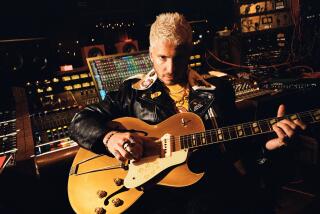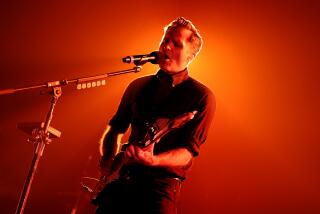Gibbs Finds Audience for Big Band Jazz
- Share via
It’s long been common knowledge in the music industry that big bands have had their day. They no longer sell records, so there is no point in recording them. Right?
Well, not entirely. At least one exception to the rule has shown that somewhere out there is a healthy body of big band jazz fans looking for some action, at least on records. The man who has filled this need is Terry Gibbs, the veteran vibraphonist, survivor of the 52nd Street bop era, one-time Goodman and Herman and Buddy Rich sideman, musical director for Steve Allen since the 1960s.
Gibbs at present does not have an orchestra. Few jazzmen do anymore. However, what he does have, and has had for many years, is a collection of tapes, recorded in 1959 when he was leading a big band regularly at a series of Los Angeles clubs.
Fast forward: After 27 years on the shelf, a set of tunes performed by the old Gibbs ensemble was released in 1986. The reaction was so strong that a second album had to be assembled, then a third last year. The records are “Terry Gibbs’ Dream Band,” Contemporary 7647; “Sundown Sessions,” 7652, and “Flyin’ Home,” 7654.
The band, using many of the same sidemen who worked with Gibbs over the years, is being reassembled for an appearance June 17 at the Hollywood Bowl during the Playboy Jazz Festival.
To say that Terry Gibbs is excited about all this would be meaningless, since Gibbs lives in a state of permanent excitement. His conversation is the precise counterpart of his dazzling vibes work; he speaks in 16th notes, and any transcribed interview has to be played back with the tape at half speed.
“It’s amazing!” he said the other day at his San Fernando Valley home. “I’ve been making records for 40 years as a leader, and suddenly, for the first time, I’m on the charts! All three albums have been in Cash Box, R&R; and Billboard. The great thing about it is, the disc jockeys now know my name, so my small-group records with Buddy de Franco are getting some attention too.”
----
The story begins with Gibbs’ move from New York to California in 1957. “When I came out here I wanted very much to make a big band album; but there was a Musicians’ Union rule that you couldn’t rehearse for a record date. However, it was all right to rehearse without payment for a nightclub job.
“Through a friend, a movie columnist named Eve Starr, I heard there was a club in town that was desperate for some kind of policy change to keep it in business. She got me into this place, the Seville, where I opened with a quintet.
“I said to the owner, ‘How would you like to try out a big band one night, for the same money you’re paying me now?’ He had nothing to lose, so he said OK. I went on Steve Allen’s NBC-TV show and he gave me a great plug; on the night of the band premiere the place was packed. We did it again the next week, and wound up working with the full orchestra five nights a week.”
The Gibbs band recorded four albums during the next three years, two each for Mercury and Verve, but Polygram, the conglomerate that now owns both those catalogues, has never reissued them. Although some of the tunes are duplicated, the performances on the three Contemporary albums are all previously unreleased.
No band is ever irrevocably dead as long as its library survives. Gibbs has the same time-proof arrangements that gave the band its original, unrestrainedly joyful character: charts by Bill Holman, Al Cohn, Bob Brookmeyer, Manny Albam, Med Flory, Marty Paich and Lennie Niehaus.
With Gibbs’ dynamic vibraphone as its indomitable centerpiece, the orchestra became the talk of the town, first at the Seville in Hollywood and later at the Sundown on the Sunset Strip.
The Dream Band drew a celebrity crowd. “Steve Allen was there regularly; so were people like Ella Fitzgerald, Dinah Shore, Louis Prima, Johnny Mercer. One night we got George Shearing to sit in, and he said: ‘Don’t play anything too hard, because I can’t read very well.’ The guys in the band took him up on the joke by calling out instructions like ‘Go to Letter C, George!’ but he’d heard the arrangements before and memorized every note.”
The venture was a labor of love for Gibbs and his cohorts. “I could have kept on making $20,000 a year just touring with a quartet, which was great money in 1959 dollars. I gave it up to stay in town and keep that band together. The men weren’t in it for the bread either; they got $15 a night, and by the time I paid the band boy I wound up with maybe $11. It takes a special attitude to be willing to lose money just because you want to have fun.”
To expedite the recent releases, Gibbs made another financial sacrifice; he paid out most of the additional salaries due to the musicians. He credits the late Dick Bock, a dedicated jazz producer, for steering him to the record company. “They gave me the kind of support jazz artists seldom get. When the records came out they let me use their phone to call up disc jockeys all over the country.”
The band that will be heard at the Playboy bash is composed of men who, with few exceptions, have worked in one or more of the group’s previous incarnations. They are, on trumpets, Conte Candoli and Snooky Young (both from the Tonight Show band), John Audino and Steve Huffsteter; on trombones, Randy Aldcroft, Charlie Loper and Bob Enevoldsen; on saxes, Med Flory and Lanny Morgen, altos; Pete Christlieb and Bob Cooper, tenors; Jack Nimitz, baritone; and the rhythm section Lou Levy, piano; Bruce Lett, bass, and Frank Capp, drums.
Gibbs won’t succumb to the temptation of taking the band on the road, an economic impossibility. “I may use the Dream Band library if there’s a suitable group in some other city--for example, there’s a band in Columbus, Ohio, that would knock you out; but for the most part I’ll be spending my time traveling with small groups.”
That, in fact, is just how he started 1989, playing 20 one-night stands around Europe in 26 days with a small unit paying tribute to Woody Herman, alongside such fellow Herman alumni as Matt Pierce, Nat Adderley and Urbie Green. He still teams up whenever possible with Buddy de Franco, his Contemporary and bebop counterpart on clarinet; in fact, he will be back at the Hollywood Bowl Aug. 23, with de Franco, in a show starring Mel Torme and Nancy Wilson.
“I’m a lucky man,” Gibbs concluded. “I saw those great years on 52nd Street; I knew my instrument well, I always knew just who I was, and I got to play with so many great musicians I respect. God has been good to me. And when I die, I’ll get to play with Charlie Parker.”
More to Read
The biggest entertainment stories
Get our big stories about Hollywood, film, television, music, arts, culture and more right in your inbox as soon as they publish.
You may occasionally receive promotional content from the Los Angeles Times.










